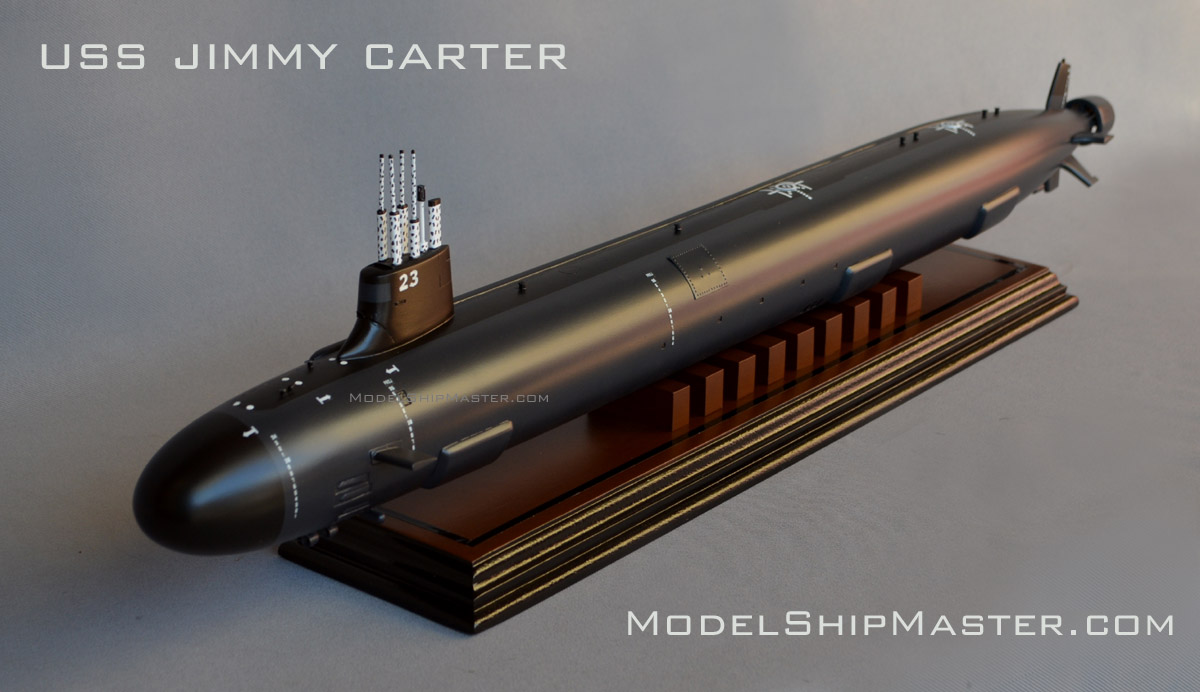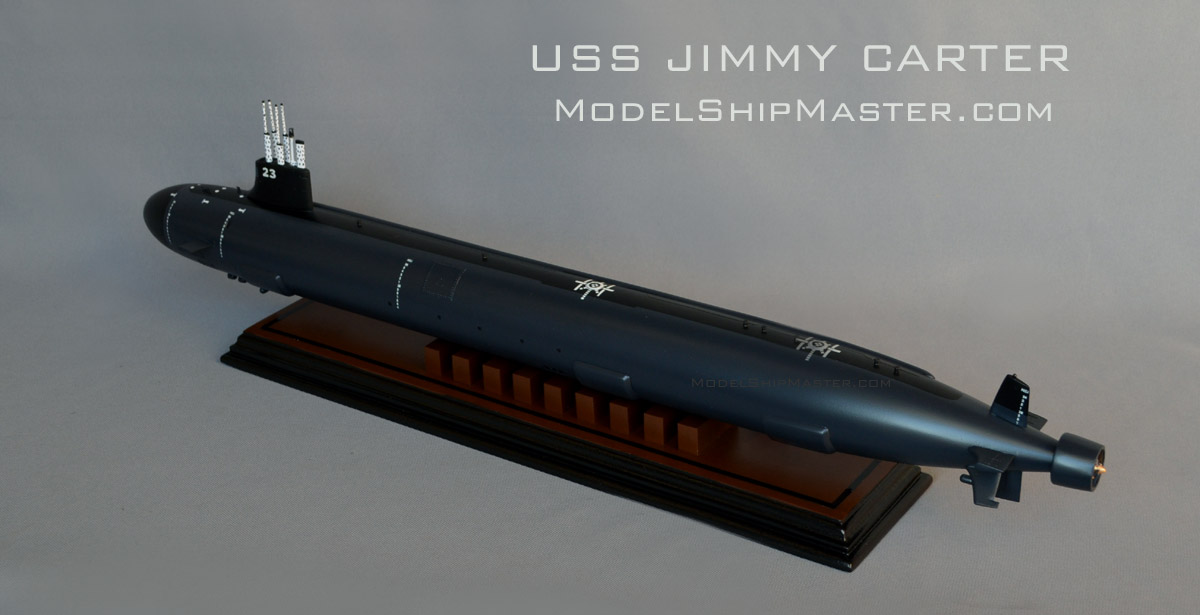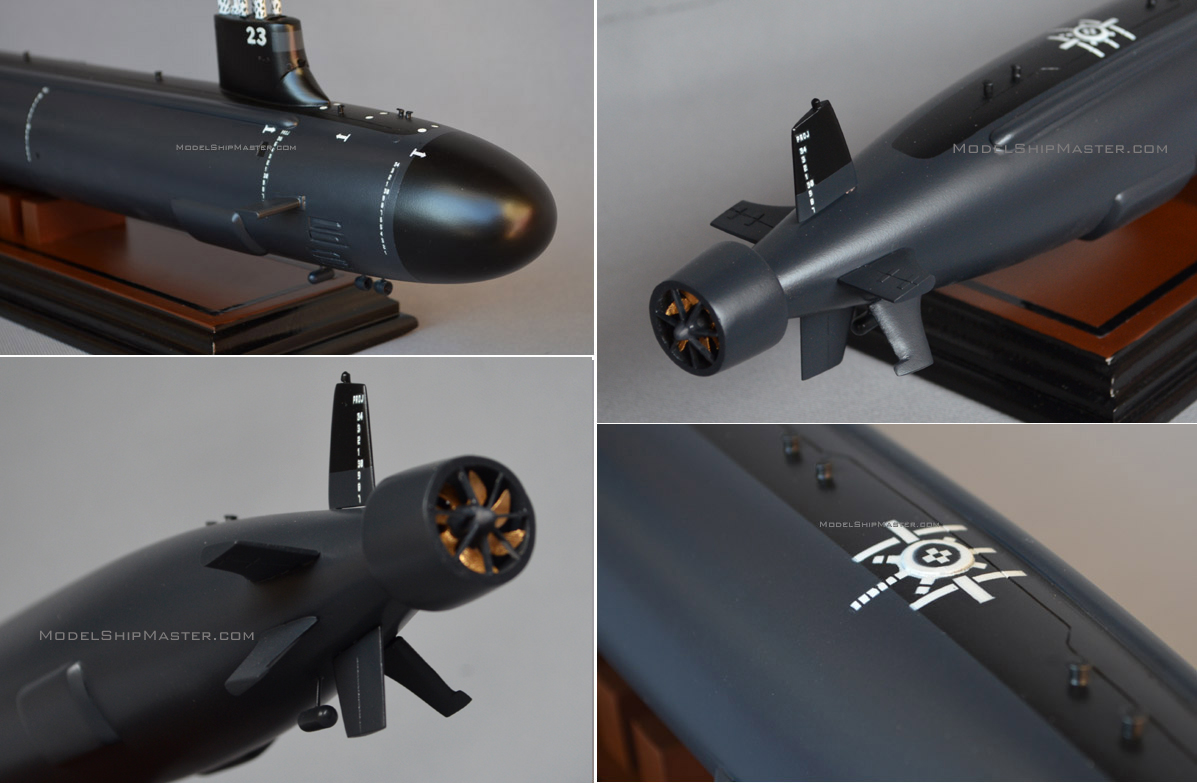|
JIMMY CARTER submarine
SSN-23
USS Jimmy Carter is the
last Seawolf class submarine. She is 100 feet longer
than the other two ships of her class due to the
insertion of a section known as the Multi-Mission
Platform, which allows launch and recovery of ROVs
and Navy SEAL forces. The expanded section is also to
make room for the same gear the
USS Parche
highly successful spy
submarine had carried into Soviet waters.

The Seawolf class submarine
USS
Jimmy Carter
can accommodate an extra 50
commandos or mission personnel above the standard crew
size of about 130. Instead of sleeping in the torpedo
room or other improvised areas as is common for special
operations soldiers aboard submarines, this berthing was
built into the original ship’s design, making long
endurance deployments more palatable. The MMP may also
be used as an underwater splicing chamber for tapping of
undersea fiber optic cables.
USS
Jimmy Carter's
ability to hold perfectly on station at great
depths allows it to tap communications and data cables
running along the sea floor. In the past, this was done
by splicing in tailor-made recording devices, leaving
them, and recovering them at a later date for
exploitation. Today, in an age of fiber optics, more
exotic forms of real-time seabed-based communication
eavesdropping could be facilitated by the Jimmy
Carter.
This Seawolf class submarine
could also be able to sabotage communications nodes via
simply cutting through the wire with large claws or
torches, or by setting up mechanisms that could do
similar tasks on command sometime in the future. Much of
this technology has been pioneered in the deep sea oil
drilling field, which can be adapted and used for
military purposes. Such an ability could partially blind
the enemy and limit their global situational awareness
and command and control capabilities.

Jimmy Carter initially served as a test
bed for studying the evolution of submarine missions in
the 21st century. She supported classified research and
development efforts for naval special warfare tasks,
tactical undersea surveillance, and undersea warfare
concepts. The Navy, with funding approved by the
Congress to complete the Multi-Mission Project, tasked
the
Seawolf class submarine
USS Jimmy Carter to provide additional volume and
functionality to support the multi-mission
opportunities. These changes did not directly impact the
submarine’s organic warfighting capabilities, but gave
her an enhanced payload capability with a more modular
architecture.

We build this
primarily wood USS Jimmy Carter
Seawolf class submarine
model
the following sizes.
- 38" long
(1/144)
$2,990 Shipping and insurance in
the contiguous USA included.
Other places: $400 flat rate.
- 27" long
(1/200)
$1,925  Shipping and insurance in
the contiguous USA included.
Other places: $300 flat rate.
This model is in stock and can be shipped within 5
business days.
Shipping and insurance in
the contiguous USA included.
Other places: $300 flat rate.
This model is in stock and can be shipped within 5
business days.
- 15.5" long (1/350)
$1,417 Shipping and insurance in
the contiguous USA included.
Other places: $200 flat rate.
This model is
built per commission only. We require only a small
deposit to start the process (not full amount, not even
half) to start the process $500  The
remaining balance won't be due until the model is
completed, in less than 6 months. The
remaining balance won't be due until the model is
completed, in less than 6 months.
One of our
Jimmy Carter
submarine
models is displayed at St Marys Submarine Museum, 102 St Marys St W, St Marys,
GA 31558. One of the largest submarine museums in
the world, St Marys Submarine Museum
is dedicated to preserving the history of
the distinguished US Submarine Force.
ModelShipMaster builds any
submarine
models, at virtually any sizes. Contact us
at
Services@ModelShipMaser.com
to inquire.

About the Seawolf class
submarines:
By the mid 1980s, the
Soviet Union’s new Akula-class submarines had a
steep drop in broadband acoustic noise profiles
after the Toshiba milling machine had been sold to
the Soviets. On top of running silent, the Akula
class could dive to depths of up to two thousand
feet—while the U.S. Navy’s frontline submarines, the
Los Angeles class, could dive to only 650 feet.
To combat the threat of the Akula class, the U.S.
Navy responded with Seawolf class submarines. The Seawolf submarines were
designed with HY-100 steel alloy hulls two inches
thick to withstand the pressures of deep
diving. HY-100 steel is roughly 20 percent
stronger than the HY-80 used in the Los Angeles
class. As a result, the submarines are capable of
diving to depths of up to two thousand feet, and
crush depth estimates run from 2,400 to 3,000 feet.
A Seawolf class submarine is powered by one
Westinghouse S6W nuclear reactor. The class was
the
first of American submarine to use
pump-jet propulsors over propellers. A Seawolf is capable of eighteen knots on the surface,
35 knots underwater, and a silent
running speed of about 20 knots.
A Seawolf class submarine is ten times quieter over the full range of
operating speeds than the improved Los Angeles
submarines, and an astonishing seventy times quieter
than the original Los Angeles class submarines. It can
run quiet at twice the speed of previous boats.
The extreme quietness of the Seawolf class gave the Navy
the idea of modifying the last submarine,
USS Jimmy Carter, to support clandestine operations.
The Seawolf class submarines were designed to be true
hunters, and as a result have eight torpedo tubes,
double the number of earlier submarines. Each has stores for up a combination
of up to fifty Mark 48 heavyweight torpedoes,
Sub-Harpoon antiship missiles, and Tomahawk missiles.
Instead of a planned fleet
of nearly 30 submarines, the Pentagon bought just three for
more than $3 billion each. At more than 350 feet long
and with a submerged displacement of more than 9,100
tons, the Seawolf class is the most expensive attack
submarine ever built and the second most expensive
undersea vessel of any type.
Learn more about the
Jimmy Carter
submarine here:
https://en.wikipedia.org/wiki/USS_Jimmy_Carter
|